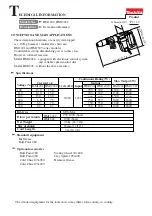
6
SPECIFICATIONS
Input Voltage
90 ~ 264Vac
No load Input Current at 230VAC
≤0.1A
Full Load Input Current at 230Vac
≤0.5A
AC Input Frequency
47Hz ~ 63Hz
Efficiency
≥75%
Power Factor
≥0.9
Constant Voltage and Current
Range Selection:
0-16V / 5A selection I 0~16.4V / 0~5.1A
0-27V / 3A selection II 0~27.6V / 0~3.1A
0-36V / 2.2A selection III 0~36.8V / 0~2.3A
Constant Voltage Characteristics :
Load Regulation (0~100%) ≤20mV
Line Regulation (±10%) ≤4mV
Ripple & Noise (p-p) ≤30mV
Constant Current Characteristics :
Load Regulation (0~100%) ≤10mA
Line Regulation (±10%) ≤10mA
Meter Accuracy :
Voltmeter Accuracy ±1% +2 counts
Ammeter Accuracy ±1% +2 counts
Protection
Adjustable Upper Voltage Limit,
Current Limiting Protection,
Short Circuit, Overload,
Over Temperature Protection
Cooling
Natural Convection
Dimensions in mm (WxHxD)
127 x 52 x 335mm / 5” (H) x 2” (W) x 13” (D).
Weight in Kg
1.9Kgs / 4.2Lbs
Remote Sensing Operation
•
In situations where the load current is very high, or when there is a long distance of
cable between the output of the supply and the load, a voltage drop can occur. This
can create problems in applications where precise voltage levels are critical. For
this situation, RS+ / RS– terminals (19) are provided on the rear panel for remote
sense connection.
Connection and operation
•
Ensure that the front panel OUTPUT selector (9) is OFF.
•
Connect the load to either the front OUTPUT (2) or rear O/P alternative output (19)
connections.
•
Using separate leads, connect the RS terminals (19) to the load as well, be careful
not to reverse polarity.
•
If desired, utilize the REVIEW (7) function to verify proper voltage and current
settings.
•
Switch the OUTPUT selector (9) ON.
Note:
Be extremely careful not to reverse the polarity between the main output and
remote sensing terminals. Do not leave the load connected to the remote sensing
terminals when not connected to the supply output. If the load must be disconnected
while the supply is on, remove the remote sensing connections first.


























